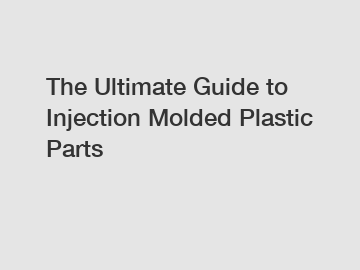The Ultimate Guide to Injection Molded Plastic Parts
The Ultimate Guide to Injection Molded Plastic Parts: What Makes Them Essential?
When it comes to manufacturing plastic parts, injection molding is a widely adopted and efficient process. But what exactly sets injection molded plastic parts apart? How does this technique work, and why are these parts so crucial in various industries? In this comprehensive guide, we will explore the ins and outs of injection molding and shed light on why it has become the go-to method for producing plastic components.
1. The Basics of Injection Molding:

Injection molding is a manufacturing process that involves injecting molten plastic material into a mold cavity. The plastic cools and solidifies within the mold, taking its desired shape. This technique offers excellent precision and repeatability, allowing manufacturers to produce intricate and complex plastic parts with ease. From small components like bottle caps to larger items such as automotive parts, injection molding caters to a wide range of sizes and complexities.
2. Speed and Cost-Efficiency:
One of the key reasons injection molding is favored in the manufacturing industry is its speed and cost-effectiveness. The process can produce a high volume of parts in a relatively short amount of time. With the help of advanced machinery and automation, manufacturers can achieve faster cycle times, resulting in increased productivity. The ability to create multiple identical parts simultaneously further enhances efficiency. Additionally, the cost per part decreases as the volume of production increases, making injection molding a cost-effective choice for mass production.
3. Design Flexibility:
Injection molded plastic parts offer immense design flexibility, allowing for the creation of intricate geometries and complex features. The mold can be tailored to suit the specific requirements of the part, including the incorporation of undercuts, threads, and surface textures. Design modifications can be implemented easily, providing manufacturers with the opportunity to iterate and improve their products without substantial retooling costs. This adaptability makes injection molding ideal for prototyping and product development.
4. Material Variety:
Plastic parts manufactured through injection molding can be produced using a wide range of materials, each with its unique properties and characteristics. Common materials include polypropylene (PP), polystyrene (PS), acrylonitrile butadiene styrene (ABS), and polyethylene (PE). The ability to choose from various materials allows manufacturers to create parts with specific mechanical, thermal, or chemical properties. Whether it's for medical devices, consumer electronics, or automotive applications, injection molding offers the flexibility to select the most suitable material for the intended use.
5. Consistency and Quality:
Injection molding ensures consistent and high-quality parts. The automated nature of the process eliminates human error and ensures precise and repeatable results. Once the mold is properly set up, each part produced will have the same dimensions and specifications. This consistency is crucial in industries where precision is of utmost importance. Moreover, injection molding offers excellent surface finishes, reducing the need for secondary operations such as sanding or painting.
6. Scalability and Efficiency:
As mentioned earlier, injection molding is highly scalable. Manufacturers can easily adjust the production volume to accommodate market demands. Whether you need a thousand or a million parts, injection molding allows for seamless scalability without compromising quality or incurring exorbitant costs. Moreover, the energy-efficient nature of the process ensures minimal material waste and reduced environmental impact, making it a sustainable manufacturing solution.
In conclusion, injection molded plastic parts are essential across various industries due to their versatility, cost-effectiveness, and design freedom. The ability to produce high-quality, precise, and consistent parts quickly sets injection molding apart. Whether it's for mass production or prototyping purposes, this manufacturing technique offers unparalleled scalability and efficiency. With its wide material selection and design flexibility, injection molding continues to revolutionize the world of plastic part production.
For more information, please visit Plastic Cnc Machining, Uhmw Plastic Sheet, Uhmw Plastic Sheet.


